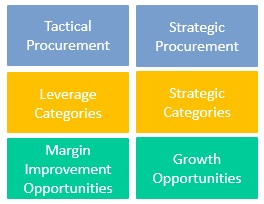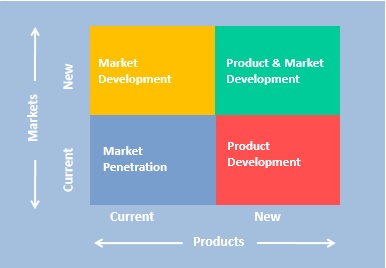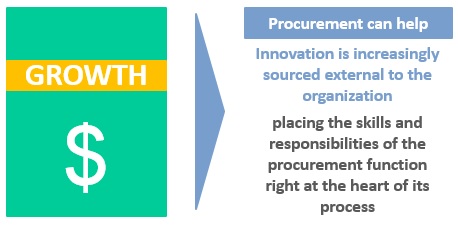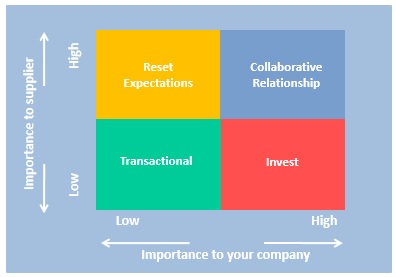The Brave CPO: Leading Business Growth
The Brave CPO: Leading Business Growth – A guide for CEO’s, CFO’s and CPO’s on how leading procurement practices can make a powerful contribution to their company’s plan for growth.
What’s in it for you?
Discover why developing capability in supply management will provide powerful fuel for growth, and why making Supply Management a Core Competency will provide a real competitive edge and prevent your company being disadvantaged in supply markets.
Reading time:
15 minutes
1. Introduction:
During the downturn, smart CEO’s will have taken the opportunity to lay down plans for the upturn and a return to growth. Part of this preparation requires a procurement function that can not only make a contribution to cost reduction, but also speed up the innovation pipeline and create value chains to fuel growth.
In most companies, however, the organizational framework and capabilities required to meet these demands is lacking. In the search for growth CEO’s need a procurement function that is more value-orientated, entrepreneurial, and embedded as a strategic core competency across the organization.
2. Supply Management – A Foundation for Growth
Procurement teams can bring new opportunities for growth to the organization
When preparing for growth, organizations must first develop the foundation. Inefficient internal processes, poor understanding of customers, a lack of skills and resources in the right places creates an organization that is ill-equipped to meet current market demands, or to sustain and leverage growth.
Organizations must understand their current environment in order to build capability in the core competencies of their business not only to sustain current business but to build the resources that will drive future growth.
Unfortunately, many organizations do not organize or support supply management as a core competency. We strongly believe that organizations must address this issue in order to compete effectively in the 21st century. Supply management as a core competency, seeks to maximize opportunities and minimize risk in external markets. Without this capability, businesses will increasingly miss opportunities to support growth and suffer supply chain inefficiencies that can actively damage growth and reputation.
2.1 A Licence to Operate
Organizational Maturity is essential for participation
For the CPO to participate in the growth agenda, procurement will need have matured beyond the basic level and have demonstrated value-adding capability. Without having done so it is unlikely to be accepted by colleagues in marketing, new product development and operations, as it will be this respect and trust that provides the licence to operate in the growth game.
In other words, they must have achieved a level of maturity to bring the following measures into place:
- Integration of procurement with both the internal organization and supplier.
- Executive sponsorship to foster links between procurement, sales & marketing, new product development as well as with human resources, etc.
- Entrepreneurship mindset to present procurement as drivers of revenue through innovation. Entrepreneurship also creates the flexibility and energy to challenge both internal and external boundaries that may prevent the ability to do things differently.
2.2 Value Added Separation
Organize for Value
Currently, in many companies, procurement fails to integrate sufficiently, being organized rigidly around cost, risk reduction and security of supply. To avoid reinforcing this image, just as procurement has disconnected transnational and strategic procurement, CPO’s should consider separating value generation and cost improvement activities (Fig 1). A new way of looking at contracts, partnerships, the supply base and the internal organization requires a different business model that allows for entrepreneurship and flexibility.
2.3 Understand your Company’s Growth Strategy:
Apply supply chain strategies aligned with the growth strategy
As a company pursues profitable growth, it typically seeks to introduce new products and enter new markets (Fig 2). It can choose to do this either through its existing activities or by entirely new activities or both, whether via a green field initiative, a joint venture, a merger or acquisition. Through early involvement, procurement can add value in the supply chain. Only by evaluating the supply chain and its capabilities, early can organizations enter a new market or launch a new product confident its supply chain can support it. Similarly with M&A, early procurement involvement is critical to capturing synergies and capturing value.
2.4 Customer Focal Point
Customer centric procurement
Growth is not about acquiring new technologies or assets; it is about winning an expanded share of existing customers business and winning new customers. It figures then that understanding customers needs and expectations is a key growth success factor. Only by understanding customer needs and their growth plans can new technologies, processes, or assets be applied effectively to deliver growth in your company.
By making customers the focal point for managing growth companies can:
- Ask major customers to quantify their growth objectives and put teams in place to help contribute to them
- Create joint growth plans with customers that strengthen each customer’s competitiveness.
- Improve customer retention by helping customers grow
The benefits of this customer-driven approach to growth are:
- Develops a strategic roadmap for future growth
- Creates an actionable plan that identifies tangible key initiatives
- Establish a clear process driven approach to planning
The CPO must ensure that procurement forms a key part of the customer focus team.
3. Procurement’s New Obligation
Innovation centered procurement is key for growth
It is difficult to discuss growth without talking about innovation. Corey Billington and Frangois Jager of IMD business school in Switzerland described innovation as procurement’s ‘new obligation’ and that supply management professionals should recognize that procurement processes lie at the core of the innovation process (Fig 3). To fulfil this new obligation it is useful to define what innovation is to your company:
-
Access to new products: When suppliers develop new products with new or improved functionality, appearance, performance, lower cost, etc. that is better than current or competitors product.
- Access to New Service: When a supplier offers improved appearance, reliability, responsiveness, competence and courtesy, etc. that is better than current or competitors service.
- Access to new processes: When a supplier offers goods or services that are faster, more productive, etc. which improve your company’s process.
Innovation may not be completely new, it just has to be new to your company or industry.
Innovation is a key enabler of growth and should be managed through the development of key capabilities to capture the value of innovation. It requires a clear strategy with metrics, a definable process to deliver the innovation and adequate resources with clear roles and responsibilities. Procurement’s role is to understand customer requirements. Identify suppliers, build relationships, negotiate terms, facilitate the evaluation process, and draw up a contract that secures the exclusivity of the product, service or process if it’s successful, for a limited period.
4. Innovation Culture
CPO’s must develop procurement entrepreneurs
In many industries today a company’s suppliers are responsible for significant technical innovation and are a source of resources and expertise. While many CEO’s cite innovation as important for their company’s growth, it is largely managed on an ad-hoc basis. For procurement, it represents a considerable obstacle. Procurement, will not effectively tap into this expertise unless the leadership promotes a culture of innovation within their company.
Prerequisites for an innovation culture include:
- Continuous and visible support from top management
- Define sponsorship and leadership
- Roles and responsibilities
- Set goals and objectives
- Establish review and tracking mechanisms
- A decentralized focus on innovation activity
- Suitable incentive structures to foster the right behaviors from employees
Unfortunately, there is often is a history of adversarial style relationships with suppliers to overcome, but this is unlikely to happen overnight. It takes time, to build long-term sustainable supplier relationships and to change their perception of buyer behavior. A company that has focused only on cost will need to spend time convincing and educating suppliers that it now wants to work with new ideas and wants to be a preferred customer to its suppliers.
Tangible steps that can be taken include:
- Involvement of senior management
- Setting clear goals and objectives for innovation from the relationship
- include innovation in the service-level agreement
- Regular discussions about what kind of new ideas suppliers can bring to the table
Such a change of approach also needs to occur with none procurement personnel in other functions that also come into day to day contact with suppliers. Their behavior must support the new way if a company is to succeed in developing successful collaboration with suppliers to drive innovation and growth.
5. SRM & Collaboration
Buyers are competing for access to their suppliers ‘A’ team
Reality dictates that a supplier can only have truly collaborative relationships with its most important customers. It is also unrealistic to remove every incentive for a supplier to collaborate with your company and at the same time ask it to commit its best people to your collaborative initiatives (Fig 3). The resources of collaboration are a scarce commodity for which companies are not only in competition for the best customers, but also for the best suppliers. It follows, therefore, that a collaborative approach to managing suppliers will be the best approach to securing these scarce resources. One focused on creating benefits for both parties and ultimately for the final customers they serve.
The engagement strategy for these critical suppliers usually consists of:
- Strategic intent
- Roles, responsibilities and governance process
- Activation process and initiative plan
- Guiding principles for the relationships
By identifying and building relationships with these suppliers procurement can pursue competitive advantage through:
- Influencing the supplier’s R&D investment to address their specific challenges
- Benefiting from the supplier’s knowledge of and experiences with other companies
- Gaining preferential access to goods and services in high demand
- Securing preferential access to supplier capacity
- Linking suppliers into the supply chain to increase service levels
- Gaining preferential access to supplier innovations
- Reducing time to market
Procurement can lead the way to the next level of collaboration, which occurs supplier to supplier. Leading companies are designing and implementing ‘value chains’ in which selected suppliers lead collaboration activities among groups of suppliers all focused on the final customer. For procurement, this is an important role in terms of leading the relationships within these value chains and your company; to secure new levels of co-operation and innovation to create value.
6. Metrics
In this brave new world, procurement performance metrics must change from price reduction to revenue generation.
Procurement managers are unlikely to drive innovation if they are not measured on it?
The results of growth initiatives may not be apparent until sometime in the future, so it can be more productive to track the ‘process’ of growth initiatives. i.e. how much effort is being applied to growth opportunities identified, rather than waiting to see if those actions were successful. Considering process inputs and outputs in one way this can be achieved:
6.1 Inputs:
Set work priorities to apportion the amount of time procurement staff spend on growth activities, i.e. 30 per cent cost management, 30 per cent stakeholder management, 20 percent risk management and 20 per cent innovation. Apply work priorities to the time spent servicing innovation in existing products and markets versus new products and markets.
Set targets for initiatives such as the number of sources explored, customer trends identified, number of technologies reviewed, innovations applied, etc.
6.2 Outputs:
Set up the review process to focus on achievement of the input targets set.
In looking at growth metrics in this way, the metrics of growth strategies measure the effectiveness of ongoing growth initiatives, not merely whether growth has occurred. Growth itself becomes the longer term result of the growth initiative process and can be measured by more traditional business metrics.
7. In Case We Forget
Cost Management remains a key value contributor to growth
Despite all the talk of procurement’s value creator aspirations, it should not be forgotten procurement’s traditional role as cost reducers plays a valuable part in providing the fuel to power growth. The savings generated by procurement can if captured, provide valuable funds for new investments which in turn power growth.
8. Conclusion
CEO’s and CPO’s must develop high levels of procurement capability within their company to achieve procurement driven growth. As they do, knit procurement strategies tighter and tighter to the business strategy, by focusing on activities that help their company’s customers grow.
By understanding customer requirements and managing the supply base to capture the ‘value of growth’. Procurement can not only generate additional funds with which to accelerate growth by funding new investments or providing additional incentives for customers. They can also provide a level of innovation from its suppliers that delivers new products, services, enhanced levels of customer satisfaction and paves the way to enter new markets.
Such ambitions are unlikely to happen without a highly skilled and accurately focused team. So whatever the economic cycle, the CPO must ensure commitment to building the capability of procurement across the organization.
Nuff said …




